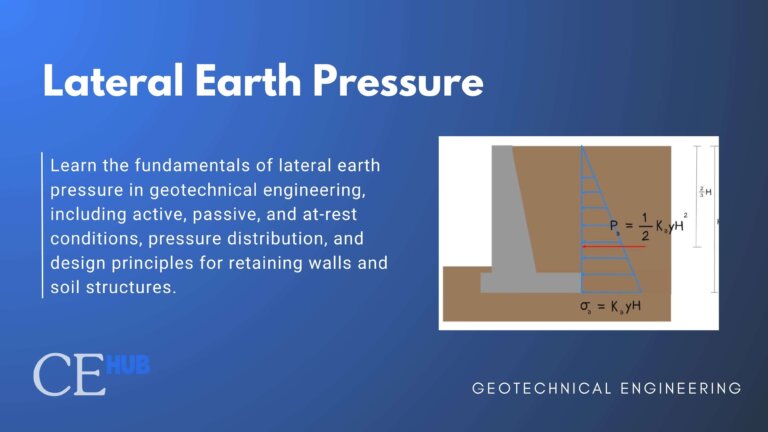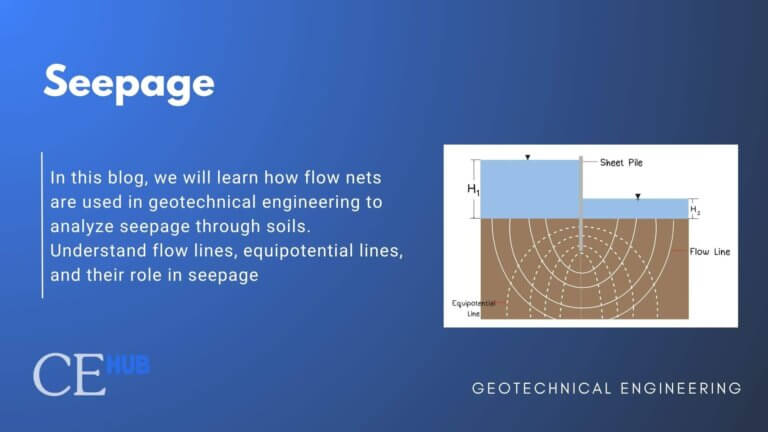Permeability in Geotechnical Engineering
What you’ll learn
Water doesn’t just sit in soil. It moves. And understanding how fast it moves and how much moves through our soil is critical for everything from dam design to groundwater contamination control to foundation drainage. Permeability is the property that tells us how easily water can flow through soil and how will it move through our foundations, under our dams, around our retaining wall, and through our ground.
What is Permeability?
Permeability in geotechnical engineering is how water flows through soil and rock masses. It’s an ability of the soil or a rock to transmit liquid through its interconnected void spaces.
The Permeability of the soil depends on several factors:
- Grain Size Distribution
- Void Ratio
- Degree of Saturation
- Soil Structure
Bernoulli’s Energy Equation
Why is there Bernoulli’s Energy Equation in Geotechnical Engineering?
Wondering why there’s Bernoulli Energy Equation when we’re dealing with Geotechnical Engineering? Well, when we analyze permeability, we’re dealing with the movement of water from points of higher hydraulic head to lower hydraulic head. The Bernoulli equation helps us understand this energy.

![]()
Where: ![]() : elevation head
: elevation head![]() : pressure
: pressure ![]() : velocity head
: velocity head
This equation can be modified into simpler terms because since the seepage velocity is small, the term velocity head can be neglected.
![]()
What this tells us is that the total energy of water at any point in the flow system stays constant and the water mover from areas of high energy to low energy.
![]()
Darcy’s Law
According to Henry Darcy in 1856, the velocity of a flow is directly proportional to the hydraulic gradient and the permeability of the soil.
He formulated this equation:
![]()
where:
v = discharge velocity
k = hydraulic conductivity
i = hydraulic gradient
For calculating actual discharge:
since
![]()
![]()
where:
Q = total discharge rate
A = cross-sectional area perpendicular to the flow
What this means? The amount of water flowing through soil depends on three things.
- How Permeable the Soil is (k)
- How steep the hydraulic hill is that the water is flowing down
- How much area the water has to flow through
Note: Darcy law is simple, it works on laminar flow, however, water can flow in turbulent manner so Darcy’s Law won’t work. But in most soils we’re dealing with, it works great.
Hydraulic Conductivity
Hydraulic conductivity (k) is the permeability of the soil expressed in a way we can actually use. It’s literally the flow rate per unit gradient per unit area. Different soils have different values.
Typical Hydraulic Conductivity Values:
| Soil Type | k (cm/s) |
| Clean Gravel | 100 – 1 |
| Coarse Sand | 1.0 – 0.01 |
| Fine Sand | 0.01 – 0.001 |
| Silty Clay | 0.001 – 0.00001 |
Hazen Formula
![]()
where:![]() = a constant that varies from 1.0 to 1.5
= a constant that varies from 1.0 to 1.5![]() = effective size in mm
= effective size in mm
mainly used for fairly uniform sand
Casagrande Formula
![]()
where: ![]() = hydraulic conductivity at void ratio
= hydraulic conductivity at void ratio ![]() = k at void ratio 0.85
= k at void ratio 0.85
The issue is that hydraulic conductivity isn’t just a property of the soil material itself. It also depends on the size of the voids, how they’re connected, and even the type of fluid flowing through.
We can’t just assume what hydraulic conductivity is. We have to measure it. And there’s two main methods to do it:
Constant Head Test
The constant head test is used to determine the coefficient of permeability, mainly for course-grained soils where maintaining a constant water level is feasible.
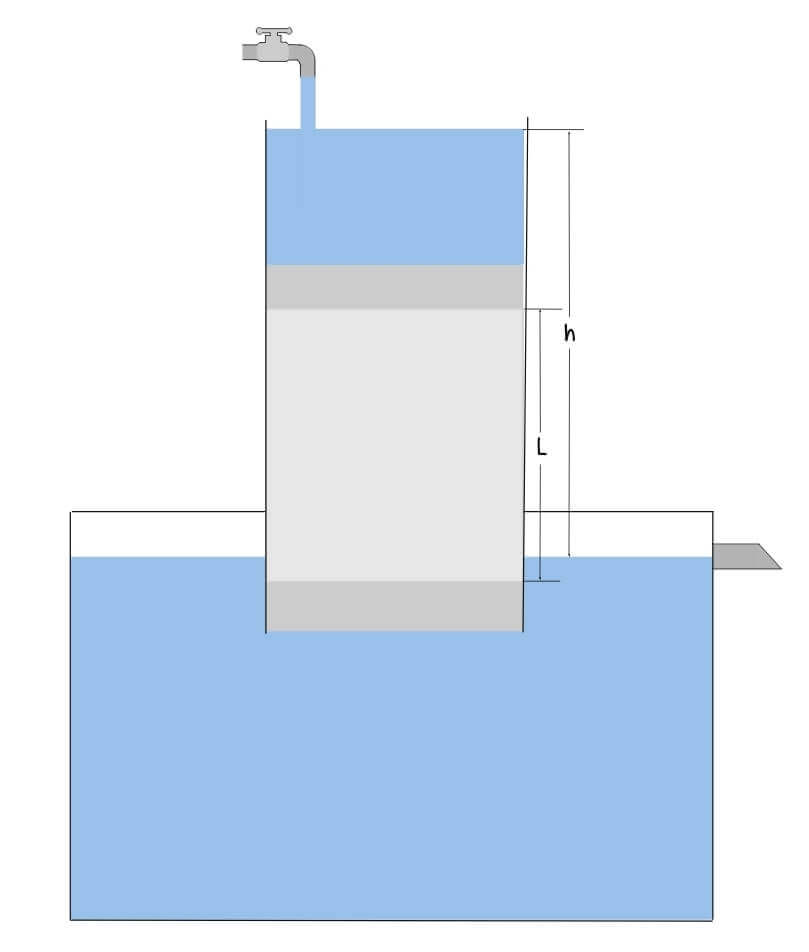
![]()
where:
k = coefficient of permeability
V = volume of water collected
L = length of soil
h = constant head difference
A = cross-sectional area of
t = time period for collection
Why is it called “constant head”?
Because the water level difference between the inlet and outlet remains unchanged during the test.
In a constant head test, you take a soil sample, put it in a column, and keep the water level the same at the top while measuring how much water flows out the bottom in a certain time.
Falling Head Test
The falling head test is a lab method we use to measure how easily water can move through fine-grained soils, like silts or clays.
Think of it as watching water slowly seep down through a narrow pipe, while keeping track of how fast the water level drops over time.
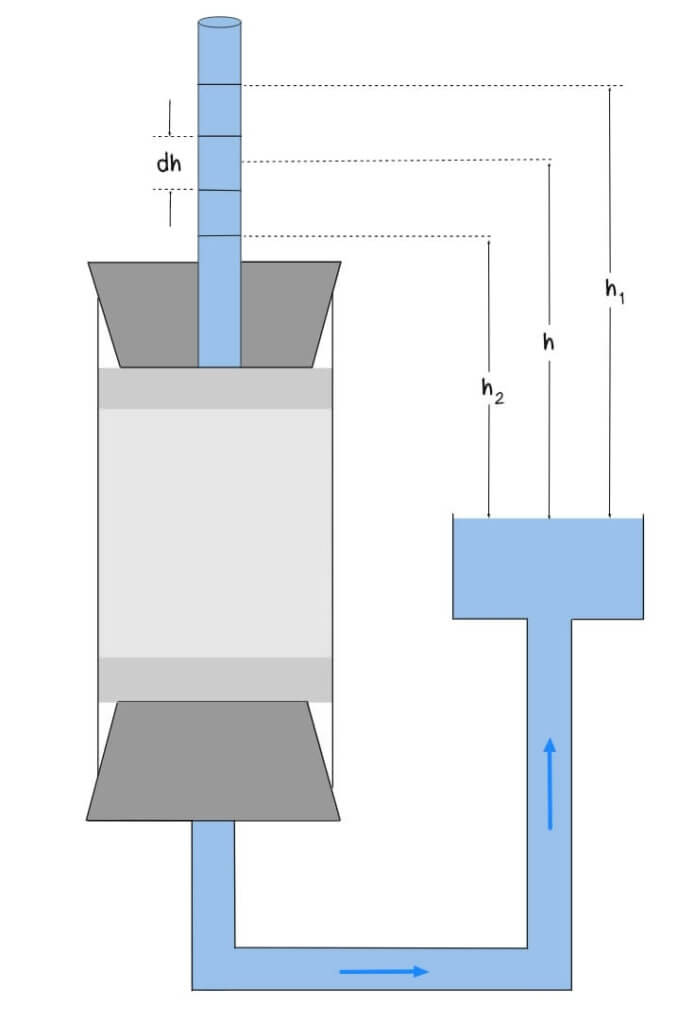
![]()
where:
a = area of the standpipe
A = area of the specimen![]() = head at time,
= head at time, ![]()
![]() = head at time,
= head at time, ![]()

Geotechnical Engineering Cheat Sheet
Master the principles of soil mechanics with this comprehensive cheat sheet. Perfect for students and professionals!
Aquifers
An aquifer is a layer of soil or rock that holds water and lets it flow.
Think of it as nature’s underground water storage tank and pipeline combined. We depend on aquifers for drinking water, irrigation, and industrial water supplies.
Types of Aquifers
Unconfined Aquifer
Unconfined aquifers have a free water surface and are open to atmospheric pressure at the top.
Water table is free to rise and fall based on rainfall. Like a sponge, it can expand and shrink.

![]()
where:
k = coefficient of permeability
Q = rate of discharge
Confined Aquifer
A confined aquifer is a layer of water-bearing rock or sediment trapped between two impermeable layers, often called aquitards or aquicludes.
Basically, like a sponge trapped in a box, it’s not free to move like in unconfined aquifers.

![]()
Transimissibility of Aquifer
![]()
Flow Through Layers of Aquifers
In real life, soil have layers. It can be sand layer, clay layer, another sand layer or combination of both.
Equivalent Hydraulic Conductivity in Parallel Flow
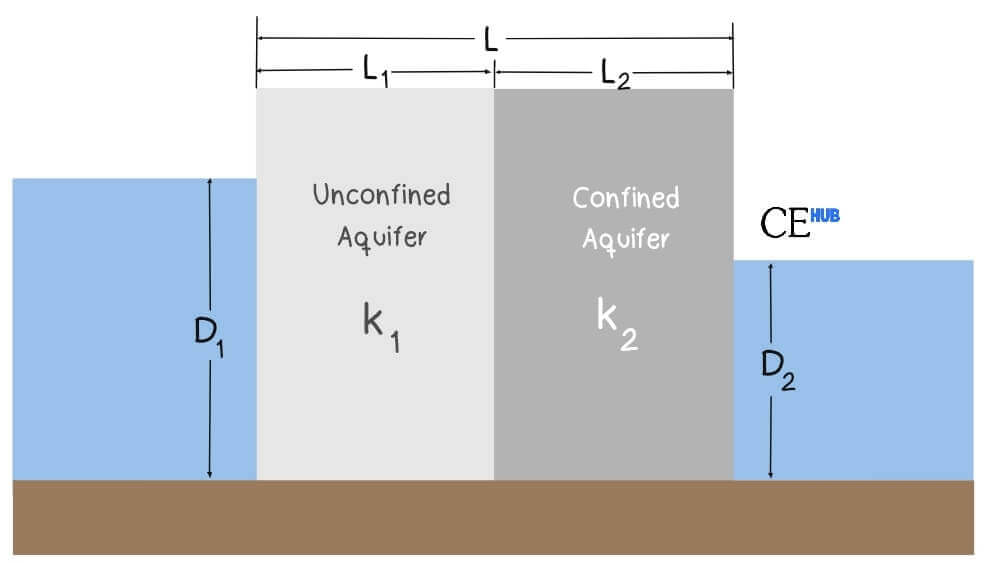
![]()
Equivalent Hydraulic Conductivity in Perpendicular Flow
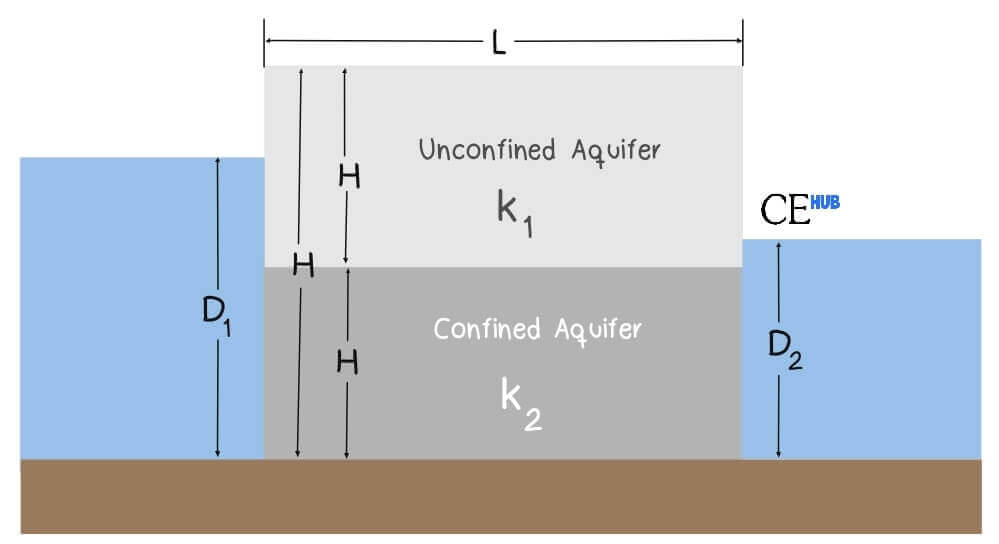
![]()
Conclusion:
It is important to know how water will move underneath especially under our foundations, dams, and retaining walls. As Civil Engineers, it is crucial to include this in the calculation as it could weaken the the soil for the foundation. And for the dams, permeability is the main reason why there’s an uplift force on the base of the dam.
References:
EE. (2020, April 5). Unconfined Aquifer – Permeability of soil – Field test. Elementary Engineering. https://elementaryengineeringlibrary.com/civil-engineering/soil-mechanics/unconfined-aquifer-permeability-of-soil-field-test/
Darcy’s Law – Definition, Applications, Properties & Limitations. (n.d.). Testbook. https://testbook.com/physics/darcys-law
Das, B. M. (2013). Fundamentals of geotechnical engineering. Cengage Learning.


